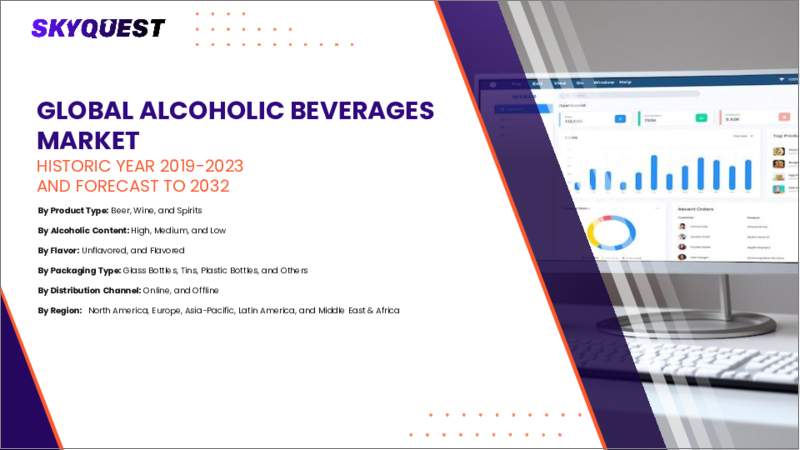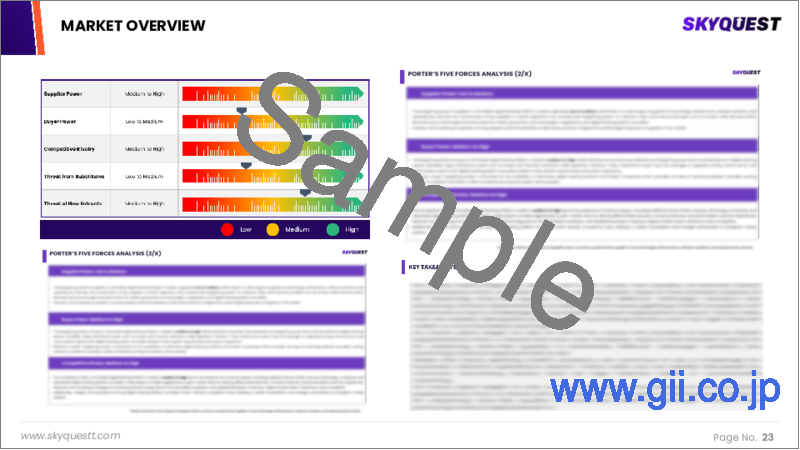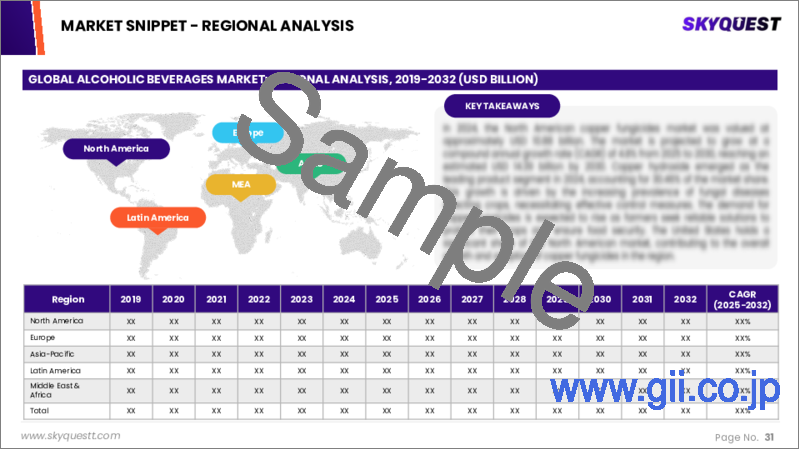|
|
市場調査レポート
商品コード
1596845
アルコール飲料の市場規模、シェア、成長分析:製品タイプ別、アルコール度数別、フレーバー別、包装タイプ別、流通チャネル別、地域別 - 産業予測、2024年~2031年Alcoholic Beverages Market Size, Share, Growth Analysis, By Product Type, By Alcohol Content, By Flavor, By Packaging Type, By Distribution Channel, By Region - Industry Forecast 2024-2031 |
||||||
|
|||||||
| アルコール飲料の市場規模、シェア、成長分析:製品タイプ別、アルコール度数別、フレーバー別、包装タイプ別、流通チャネル別、地域別 - 産業予測、2024年~2031年 |
|
出版日: 2024年11月21日
発行: SkyQuest
ページ情報: 英文 242 Pages
納期: 3~5営業日
|
全表示
- 概要
- 目次
世界のアルコール飲料の市場規模は、2022年に1兆5,420億9,000万米ドルとなり、2023年の1兆5,791億米ドルから、2031年までには1兆9,090億1,000万米ドルに成長し、予測期間(2024年~2031年)のCAGRは2,4%で成長する見通しです。
世界のアルコール飲料市場は、急増する若年人口、中間層の拡大、堅調な経済状況によって大きな成長を遂げています。この市場拡大を後押しする主要な要因としては、ウォッカ、フレーバーワイン、ビール、カクテルなどの人気飲料の製造における技術進歩、消費者のライフスタイルや選好の進化などが挙げられます。さらに、世界中の醸造所やワイナリーの数が増加していることも、このダイナミックな情勢に寄与しています。様々な文化が長い歴史の中でアルコール飲料を消費してきた一方で、今日の市場は主に地域の特産品で占められており、大量生産品に移行できるものはわずかです。ブドウから造られるワインや大麦から造られるビールのような蒸留酒は、現在では商品と見なされており、生産コストや関税が価格構造に大きく影響し、国や時代によって弾力性が異なります。若年層消費者の増加が予想されるため、特にプレミアムやスーパープレミアムの需要が高まると予想されます。しかし、アルコール消費が健康に及ぼす影響に関する懸念が、この分野の成長を抑制する可能性があります。さらに、プレミアムおよびウルトラプレミアム製品に関連するコストの上昇が、市場拡大のさらなる課題となる可能性があります。まとめると、アルコール飲料市場は有望な成長ポテンシャルを示す一方で、今後数年間の軌跡を左右しかねない課題に直面しています。
目次
イントロダクション
- 調査の目的
- 調査範囲
- 定義
調査手法
- 情報調達
- 二次データと一次データの方法
- 市場規模予測
- 市場の前提条件と制限
エグゼクティブサマリー
- 世界市場の見通し
- 供給と需要のトレンド分析
- セグメント別機会分析
市場力学と見通し
- 市場概要
- 市場規模
- 市場力学
- 促進要因と機会
- 抑制要因と課題
- ポーター分析と影響
- 競争企業間の敵対関係
- 代替品の脅威
- 買い手の交渉力
- 新規参入業者の脅威
- 供給企業の交渉力
主要な市場の考察
- 主要な成功要因
- 競合の程度
- 主要な投資機会
- 市場エコシステム
- PESTEL分析
- マクロ経済指標
- 市場の魅力指数
- バリューチェーン分析
- 価格分析
- 規制分析
- 原材料の分析
- ケーススタディ分析
世界のアルコール飲料の市場規模:製品タイプ別・CAGR(2024年~2031年)
- 市場概要
- ビール
- エール
- ラガー
- ハイブリッド
- ワイン
- スティルライトワイン
- スパークリングワイン
- スピリッツ
- 白酒
- ウォッカ
- ウィスキー
- ラム酒
- リキュール
- ジン
- テキーラ
- その他
世界のアルコール飲料の市場規模:アルコール含度数別・CAGR(2024年~2031年)
- 市場概要
- 高
- 中
- 低
世界のアルコール飲料の市場規模:フレーバー別・CAGR(2024年~2031年)
- 市場概要
- 無味
- 風味付けされた
世界のアルコール飲料の市場規模:包装タイプ別・CAGR(2024年~2031年)
- 市場概要
- ガラス瓶
- 缶詰
- プラスチックボトル
- その他
世界のアルコール飲料の市場規模:流通チャネル別・CAGR(2024年~2031年)
- 市場概要
- オントレード
- オフトレード
- スーパーマーケット / ハイパーマーケット
- 専門店
- オンラインストア
- その他のオフトレードチャネル
世界のアルコール飲料の市場規模・CAGR(2024年~2031年)
- 北米(製品タイプ、アルコール度数、フレーバー、包装タイプ、流通チャネル)
- 米国
- カナダ
- 欧州(製品タイプ、アルコール度数、フレーバー、包装タイプ、流通チャネル)
- 英国
- ドイツ
- スペイン
- フランス
- イタリア
- その他欧州地域
- アジア太平洋(製品タイプ、アルコール度数、フレーバー、包装タイプ、流通チャネル)
- 中国
- インド
- 日本
- 韓国
- その他アジア太平洋
- ラテンアメリカ(製品タイプ、アルコール度数、フレーバー、包装タイプ、流通チャネル)
- ブラジル
- その他ラテンアメリカ地域
- 中東・アフリカ(製品タイプ、アルコール度数、フレーバー、包装タイプ、流通チャネル)
- GCC諸国
- 南アフリカ
- その他中東・アフリカ
競合情報
- 上位5社の比較
- 主要企業の市場ポジショニング(2023年)
- 主要な市場企業が採用した戦略
- 市場の最近の動向
- 企業の市場シェア分析(2023年)
- 主要企業の企業プロファイル
- 会社概要
- 製品ポートフォリオ分析
- セグメント別シェア分析
- 収益の前年比比較(2021年~2023年)
主要企業プロファイル
- Anheuser-Busch InBev(Belgium)
- Asahi Group Holdings, Ltd.(Japan)
- Accolade Wines(Australia)
- Bacardi(Bermuda)
- Brown-Forman(US)
- Carlsberg(Denmark)
- CASTEL FRERES(France)
- Constellation Brands, Inc.(US)
- Diageo(UK)
- Halewood Sales(UK)
- Heineken Holding N.V.(Netherlands)
- Mike's Hard Lemonade Co.(US)
- Miller Brewing Co.(US)
- Molson Coors Beverage Company(US)
- Pernod Ricard(France)
- Suntory Holdings Limited(Japan)
- Blossoms Aroma Private Limited(India)
- United Spirits Limited(Food and Beverage Manufacturing)(India)
- Kals Distilleries Private Limited(India)
- Ashoka Distillers & Chemicals Private Limited(India)
結論と提言
Global Alcoholic Beverages Market size was valued at USD 1542.09 billion in 2022 and is poised to grow from USD 1579.10 billion in 2023 to USD 1909.01 billion by 2031, growing at a CAGR of 2,4% during the forecast period (2024-2031).
The global alcoholic beverages market is witnessing significant growth driven by a burgeoning young population, an expanding middle class, and robust economic conditions. Key factors propelling this market expansion include technological advancements in the production of popular drinks such as vodka, flavored wines, beers, and cocktails, alongside evolving consumer lifestyles and preferences. Moreover, the increase in the number of breweries and wineries around the globe contributes to this dynamic landscape. While various cultures have a long history of consuming alcoholic beverages, today's market is primarily dominated by regional specialties, with only a few able to transition into mass-produced products. Distilled spirits like wines from grapes and beers from barley are now viewed as commodities, with production costs and tariffs significantly affecting pricing structures that yield varying elasticities across different countries and time periods. The anticipated rise in young adult consumers is expected to bolster demand, particularly for premium and super-premium options. However, concerns regarding the health implications of alcohol consumption may temper growth in this sector. Additionally, the rising costs associated with premium and ultra-premium products might further challenge market expansion. In summary, while the alcoholic beverages market exhibits promising growth potential, it faces challenges that could influence its trajectory in the coming years.
Top-down and bottom-up approaches were used to estimate and validate the size of the Global Alcoholic Beverages market and to estimate the size of various other dependent submarkets. The research methodology used to estimate the market size includes the following details: The key players in the market were identified through secondary research, and their market shares in the respective regions were determined through primary and secondary research. This entire procedure includes the study of the annual and financial reports of the top market players and extensive interviews for key insights from industry leaders such as CEOs, VPs, directors, and marketing executives. All percentage shares split, and breakdowns were determined using secondary sources and verified through Primary sources. All possible parameters that affect the markets covered in this research study have been accounted for, viewed in extensive detail, verified through primary research, and analyzed to get the final quantitative and qualitative data.
Global Alcoholic Beverages Market Segmental Analysis
Global Alcoholic Beverages Market is segmented by product type, alcoholic content, flavor, packaging type, distribution channel and region. Based on product type, the market is segmented into beer, wine, spirits. Based on alcoholic content, the market is segmented into high, medium, low. Based on flavor, the market is segmented into unflavored, flavored. Based on packaging type, the market is segmented into glass bottles, tins, plastic bottles, others. Based on distribution channel, the market is segmented into on-trade, off-trade. Based on region, the market is segmented into North America, Europe, Asia Pacific, Latin America and Middle East & and Africa.
Driver of the Global Alcoholic Beverages Market
The Global Alcoholic Beverages market is significantly influenced by multiple factors driving its expansion. Rising disposable incomes and increasing urbanization in emerging economies have led to a surge in nightlife activities, such as visiting bars and nightclubs. Young individuals, particularly those from affluent families, are driving demand through social media influence and accessibility to alcoholic drinks. Urban stressors have also contributed to higher alcohol consumption, as many view drinking as a way to unwind. Additionally, producers are innovating with new flavors, attracting curious consumers, especially millennials. The pandemic saw a spike in beer and dark liquor sales, prompting major industry players to leverage e-commerce platforms, enhancing market potential. Moreover, burgeoning interest in artisanal spirits in regions like China and India presents further growth opportunities, particularly for competitively priced, value-added products like hard seltzers. However, a concurrent rise in the popularity of non-alcoholic alternatives poses challenges, compelling brands to focus on lower alcohol content offerings to meet health-conscious consumer preferences.
Restraints in the Global Alcoholic Beverages Market
The growth of the global alcoholic beverages market is being hindered by a rising consumer preference for non-alcoholic options. Additionally, potential new entrants into the alcoholic beverages industry face substantial barriers, including the necessity for significant capital investment, resource allocation, and compliance with governmental legal certifications. These challenges contribute to lengthy processing times, further restricting market expansion. Moreover, an increasing awareness of health and wellness among consumers is likely to curtail the market's growth prospects throughout the forecast period, as individuals gravitate towards healthier beverage alternatives in light of changing lifestyles and preferences.
Market Trends of the Global Alcoholic Beverages Market
The Global Alcoholic Beverages market is witnessing a significant shift towards low- and no-alcohol options, propelled by a growing cohort of health-conscious consumers and a surge in social media marketing. This trend is bolstered by the increasing curiosity of sober drinkers who seek inclusive social experiences without the alcohol content. Major retailers, including Whole Foods, are embracing this shift by prominently featuring trendy low- and no-calorie products in their top offerings. Additionally, local breweries are innovating with non-alcoholic beer and alternative beverages, indicating that this movement is not a passing fad, but a lasting evolution in consumer preferences and market dynamics.
Table of Contents
Introduction
- Objectives of the Study
- Scope of the Report
- Definitions
Research Methodology
- Information Procurement
- Secondary & Primary Data Methods
- Market Size Estimation
- Market Assumptions & Limitations
Executive Summary
- Global Market Outlook
- Supply & Demand Trend Analysis
- Segmental Opportunity Analysis
Market Dynamics & Outlook
- Market Overview
- Market Size
- Market Dynamics
- Driver & Opportunities
- Restraints & Challenges
- Porters Analysis & Impact
- Competitive rivalry
- Threat of substitute
- Bargaining power of buyers
- Threat of new entrants
- Bargaining power of suppliers
Key Market Insights
- Key Success Factors
- Degree of Competition
- Top Investment Pockets
- Market Ecosystem
- PESTEL Analysis
- Macro-Economic Indicators
- Market Attractiveness Index
- Value Chain Analysis
- Pricing Analysis
- Regulatory Analysis
- Raw Material Analysis
- Case Study Analysis
Global Alcoholic Beverages Market Size by Product Type & CAGR (2024-2031)
- Market Overview
- Beer
- Ale
- Lager
- Hybrid
- Wine
- Still Light Wine
- Sparkling Wine
- Spirits
- Baijiu
- Vodka
- Whiskey
- Rum
- Liqueurs
- Gin
- Tequila
- Others
Global Alcoholic Beverages Market Size by Alcoholic Content & CAGR (2024-2031)
- Market Overview
- High
- Medium
- Low
Global Alcoholic Beverages Market Size by Flavor & CAGR (2024-2031)
- Market Overview
- Unflavored
- Flavored
Global Alcoholic Beverages Market Size by Packaging Type & CAGR (2024-2031)
- Market Overview
- Glass Bottles
- Tins
- Plastic Bottles
- Others
Global Alcoholic Beverages Market Size by Distribution Channel & CAGR (2024-2031)
- Market Overview
- On-trade
- Off -trade
- Supermarkets/Hypermarkets
- Specialist Stores
- Online Stores
- Other Off-trade Channels
Global Alcoholic Beverages Market Size & CAGR (2024-2031)
- North America, (Product Type, Alcoholic Content, Flavor, Packaging Type, Distribution Channel)
- US
- Canada
- Europe, (Product Type, Alcoholic Content, Flavor, Packaging Type, Distribution Channel)
- UK
- Germany
- Spain
- France
- Italy
- Rest of Europe
- Asia-Pacific, (Product Type, Alcoholic Content, Flavor, Packaging Type, Distribution Channel)
- China
- India
- Japan
- South Korea
- Rest of Asia Pacific
- Latin America, (Product Type, Alcoholic Content, Flavor, Packaging Type, Distribution Channel)
- Brazil
- Rest of Latin America
- Middle East & Africa, (Product Type, Alcoholic Content, Flavor, Packaging Type, Distribution Channel)
- GCC Countries
- South Africa
- Rest of Middle East & Africa
Competitive Intelligence
- Top 5 Player Comparison
- Market Positioning of Key Players, 2023
- Strategies Adopted by Key Market Players
- Recent Developments in the Market
- Company Market Share Analysis, 2023
- Company Profiles of All Key Players
- Company Details
- Product Portfolio Analysis
- Company's Segmental Share Analysis
- Revenue Y-O-Y Comparison (2021-2023)
Key Company Profiles
- Anheuser-Busch InBev (Belgium)
- Company Overview
- Business Segment Overview
- Financial Updates
- Key Developments
- Asahi Group Holdings, Ltd. (Japan)
- Company Overview
- Business Segment Overview
- Financial Updates
- Key Developments
- Accolade Wines (Australia)
- Company Overview
- Business Segment Overview
- Financial Updates
- Key Developments
- Bacardi (Bermuda)
- Company Overview
- Business Segment Overview
- Financial Updates
- Key Developments
- Brown-Forman (US)
- Company Overview
- Business Segment Overview
- Financial Updates
- Key Developments
- Carlsberg (Denmark)
- Company Overview
- Business Segment Overview
- Financial Updates
- Key Developments
- CASTEL FRERES (France)
- Company Overview
- Business Segment Overview
- Financial Updates
- Key Developments
- Constellation Brands, Inc. (US)
- Company Overview
- Business Segment Overview
- Financial Updates
- Key Developments
- Diageo (UK)
- Company Overview
- Business Segment Overview
- Financial Updates
- Key Developments
- Halewood Sales (UK)
- Company Overview
- Business Segment Overview
- Financial Updates
- Key Developments
- Heineken Holding N.V. (Netherlands)
- Company Overview
- Business Segment Overview
- Financial Updates
- Key Developments
- Mike's Hard Lemonade Co. (US)
- Company Overview
- Business Segment Overview
- Financial Updates
- Key Developments
- Miller Brewing Co. (US)
- Company Overview
- Business Segment Overview
- Financial Updates
- Key Developments
- Molson Coors Beverage Company (US)
- Company Overview
- Business Segment Overview
- Financial Updates
- Key Developments
- Pernod Ricard (France)
- Company Overview
- Business Segment Overview
- Financial Updates
- Key Developments
- Suntory Holdings Limited (Japan)
- Company Overview
- Business Segment Overview
- Financial Updates
- Key Developments
- Blossoms Aroma Private Limited (India)
- Company Overview
- Business Segment Overview
- Financial Updates
- Key Developments
- United Spirits Limited (Food and Beverage Manufacturing) (India)
- Company Overview
- Business Segment Overview
- Financial Updates
- Key Developments
- Kals Distilleries Private Limited (India)
- Company Overview
- Business Segment Overview
- Financial Updates
- Key Developments
- Ashoka Distillers & Chemicals Private Limited (India)
- Company Overview
- Business Segment Overview
- Financial Updates
- Key Developments






